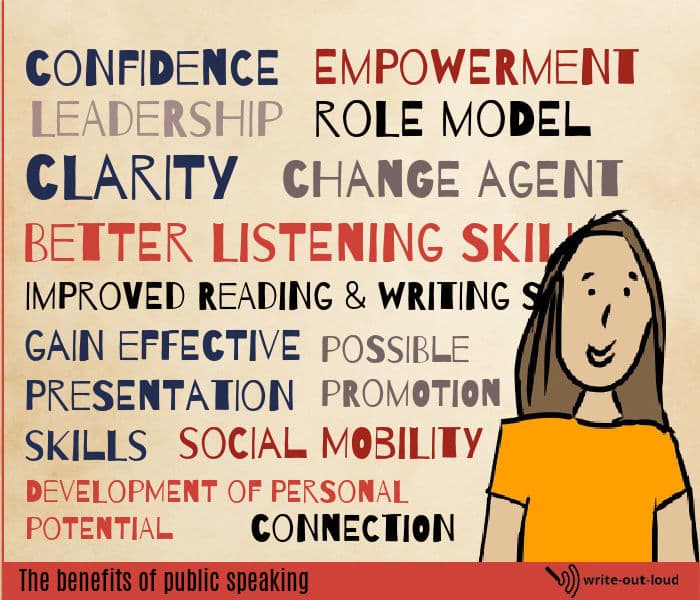Ethnocentrism in Public Speaking and Communication
Ethnocentrism in public speaking is the tendency to evaluate other cultures or individuals based on the standards of one’s own culture. It can hinder effective communication and lead to misunderstandings and biases in public speaking.
Ethnocentrism can be overcome by promoting cultural understanding, embracing diversity, and respecting different perspectives and beliefs. In a globalized world, it is crucial for public speakers to be aware of their own biases and strive for cultural sensitivity and inclusivity.
By doing so, they can engage their audience more effectively and foster a sense of unity and appreciation for diverse perspectives. As public speakers, it is important to recognize the impact of ethnocentrism and actively work towards promoting cultural understanding and inclusivity in our speeches.
Understanding Ethnocentrism In Public Speaking
Ethnocentrism in public speaking: Understanding the impact of cultural bias on communication and how it can hinder effective engagement with diverse audiences. Gain insights into overcoming this challenge and promoting inclusivity in your presentations.
Ethnocentrism refers to the belief that one’s own culture, ethnicity, or group is superior to others. In the context of public speaking, ethnocentrism can have a significant impact on both the speaker and the audience. This section will delve into the definition and explanation of ethnocentrism, its impact on public speaking, and the prevalence of cultural biases and prejudices in this domain.
Definition And Explanation Of Ethnocentrism
- Ethnocentrism: This term refers to the tendency of individuals or groups to view their own culture as superior to others. It involves the belief that one’s customs, values, and norms are the most correct and desirable, often leading to a biased perspective.
- Cultural superiority: Ethnocentrism often stems from an assumption of cultural superiority, where individuals or groups believe that their own cultural practices are superior to those of other cultures.
- Lack of cultural awareness: Ethnocentrism can result in a lack of understanding and appreciation for diverse cultures, leading to a narrow worldview and potential misunderstandings when communicating with individuals from different cultural backgrounds.
The Impact Of Ethnocentrism On Public Speaking
- Cultural insensitivity: Ethnocentrism can lead to cultural insensitivity in public speaking, where the speaker fails to consider or acknowledge the diverse backgrounds of the audience. This can result in a lack of connection and engagement with the audience.
- Misinterpretation: Ethnocentrism can hinder effective communication in public speaking as speakers might assume that their cultural references, jokes, or examples are universally understood. This can lead to misinterpretation or alienation of certain audience members.
- Limited perspective: Ethnocentrism limits a speaker’s understanding and appreciation of different cultural viewpoints. This can restrict the ability to deliver a well-rounded speech that resonates with a diverse audience.
- Stereotyping: Ethnocentrism can reinforce stereotypes and prejudices. Speakers may unknowingly rely on stereotypes when discussing cultures other than their own, perpetuating harmful biases and misinformation.
Cultural Biases And Prejudices In Public Speaking
- Stereotypes and generalizations: Public speakers influenced by ethnocentrism may unknowingly use stereotypes or generalizations when discussing cultures different from their own. This can result in oversimplification and misrepresentation of diverse cultures.
- Linguistic bias: Ethnocentrism can manifest as linguistic bias, where speakers prioritize certain languages or accents over others. This can create a hierarchy that marginalizes speakers of non-dominant languages or accents.
- Lack of cultural representation: Ethnocentrism can lead to a lack of cultural representation in public speaking platforms. This can result in certain voices being unheard or underrepresented, limiting the diversity of perspectives shared with the audience.
- Cultural appropriation: Ethnocentrism can contribute to cultural appropriation in public speaking, where speakers may borrow or adopt practices, symbols, or attire from a culture without proper understanding or respect. This can be seen as disrespectful and offensive.
Understanding and addressing ethnocentrism in public speaking is crucial for promoting inclusivity, cultural understanding, and effective communication. Public speakers should strive to be culturally aware, appreciate diversity, and avoid falling into the trap of ethnocentric biases and prejudices.
Overcoming Ethnocentrism Through Awareness
Raise awareness and overcome ethnocentrism through impactful public speaking. Combat prejudices and encourage inclusivity by promoting cultural understanding and appreciation. Embrace diversity and foster a more tolerant society through the power of effective communication.
Ethnocentrism is a common tendency among individuals to view their own culture or group as superior to others. While it is natural to have some degree of ethnocentric bias, allowing this mindset to dominate one’s public speaking can hinder effective communication and lead to the alienation of diverse audiences.
The key to overcoming ethnocentrism in public speaking lies in promoting cultural awareness, recognizing and addressing our own ethnocentric tendencies, and developing empathy and understanding towards diverse audiences.
Promoting Cultural Awareness In Public Speaking:
- Educate yourself about different cultures, traditions, and customs: Conduct thorough research to gain knowledge and understanding of diverse cultural backgrounds. This will help you avoid making assumptions and generalizations about your audience.
- Incorporate multicultural elements into your speech: Use examples, stories, and visuals that reflect the diversity of your audience. Including a variety of cultural references will make your speech more relatable and inclusive.
- Seek feedback from individuals with different cultural backgrounds: Engage with members of diverse communities and ask for their input and perspectives. Their insights can help you tailor your speech to be more culturally sensitive and appropriate.
Recognizing And Addressing Ethnocentric Tendencies:
- Reflect on your own biases and stereotypes: Take the time to examine your personal attitudes and beliefs towards different cultures. By being aware of your own ethnocentric tendencies, you can actively work towards overcoming them.
- Challenge your assumptions: Be open-minded and willing to question preconceived notions or stereotypes you may hold about certain cultures. Treat each audience member as an individual, rather than making assumptions based on their cultural background.
- Understand the impact of ethnocentrism on communication: Recognize that ethnocentrism can hinder effective communication and create barriers between you and your audience. It is important to strive for mutual understanding and respect.
Developing Empathy And Understanding For Diverse Audiences:
- Adapt your communication style to meet the needs of diverse audiences: Different cultural backgrounds may have varied preferences for communication styles. Adjust your tone, language, and delivery to ensure that your message is accessible to everyone.
- Listen actively to your audience: Pay attention to verbal and nonverbal cues from your audience members. This will help you gauge their engagement and adjust your speech accordingly.
- Foster an inclusive environment: Encourage participation and create opportunities for diverse voices to be heard. By valuing and validating different perspectives, you will foster an atmosphere of inclusion and open dialogue.
By promoting cultural awareness, recognizing and addressing ethnocentric tendencies, and developing empathy and understanding for diverse audiences, you can be a more effective public speaker who connects with and respects people from all walks of life. Embracing diversity in your public speaking will not only widen your reach but also contribute to a more inclusive society as a whole.
Strategies For Effective Cross-Cultural Communication
Discover effective strategies for ethnocentrism public speaking and overcome cross-cultural communication barriers. Enhance your ability to connect with diverse audiences and deliver impactful presentations.
Ethnocentrism Public Speaking:
Ethnocentrism Public Speaking can be a challenging task, especially when it comes to communicating effectively with individuals from different cultural backgrounds. In order to bridge the cultural gap and deliver a successful speech, it is crucial to understand and adapt to the communication styles of diverse cultures.
Here are some strategies that can help you enhance your cross-cultural communication skills:
Adapting Communication Styles To Different Cultures:
- Research the cultural background: Before preparing your speech, take the time to learn about the cultural norms, values, and communication styles of your audience. This will enable you to tailor your message in a way that resonates with them.
- Speak at an appropriate pace: Different cultures have varying preferences when it comes to the speed of speech. While some cultures value faster-paced delivery, others appreciate a more leisurely approach. Adjust your speaking pace accordingly to ensure clarity and comprehension.
- Consider indirect communication: In some cultures, direct communication may be considered rude or confrontational. To be more culturally sensitive, incorporate indirect language and use non-confrontational expressions to convey your message.
Using Nonverbal Cues Effectively In Cross-Cultural Contexts:
- Pay attention to body language: Nonverbal cues play a significant role in communicating across cultures. Be aware of gestures, facial expressions, and body language that may have different meanings in various cultures. Adjust your own nonverbal cues to align with cultural norms, while still maintaining authenticity.
- Be mindful of personal space: The concept of personal space varies across cultures. Respecting personal boundaries demonstrates cultural sensitivity. Ensure that you maintain an appropriate distance while engaging with your audience.
Incorporating Inclusive Language In Public Speaking:
- Use gender-neutral language: To create an inclusive environment, avoid using gender-specific terms or pronouns. Opt for gender-inclusive language that encompasses all individuals.
- Respect cultural sensitivities: Be aware of potentially sensitive topics or language that may offend certain cultures. Use inclusive language that respects diverse backgrounds and avoids discriminatory language or stereotypes.
- Encourage audience participation: Engaging your audience is an effective way to foster cross-cultural understanding. Encourage individuals from different cultures to share their perspectives and experiences, promoting inclusivity and diverse viewpoints.
By adapting your communication style, utilizing nonverbal cues effectively, and incorporating inclusive language, you can overcome cultural barriers and deliver impactful public speeches to diverse audiences. With these strategies in place, you’ll be better equipped to connect with individuals of different cultural backgrounds, fostering understanding and harmony in your public speaking engagements.
Best Practices For Embracing Diversity In Public Speaking
Discover the best ways to embrace diversity in public speaking and overcome ethnocentrism. Learn effective strategies to create inclusive presentations that engage audiences and promote cultural understanding.
Ethnocentrism Public Speaking:
Public speaking is a powerful tool that allows individuals to express their ideas, opinions, and knowledge to diverse audiences. However, to truly connect with and engage these audiences, it is essential to embrace diversity and create inclusive environments. In this section, we will explore three best practices for embracing diversity in public speaking:
Creating Inclusive Environments For Diverse Audiences:
- Acknowledge and respect cultural differences: Recognize that your audience may come from various cultural backgrounds and have different values, norms, and traditions. Ensure that your content and delivery are inclusive and sensitive to these differences.
- Use inclusive language: Choose words and phrases that are inclusive and avoid any language that may be offensive or exclusionary. By doing so, you can make all members of your audience feel valued and included.
- Provide visual aids and materials that reflect diversity: Incorporate visuals, videos, and examples from diverse cultures and perspectives. This helps create a more inclusive and relatable experience for your audience.
Engaging In Intercultural Dialogue And Collaboration:
- Seek opportunities for cross-cultural learning: Engage in conversations and interactions with individuals from different cultural backgrounds. This allows you to gain insights, perspectives, and knowledge that can enrich your content and delivery.
- Foster an environment of open-mindedness: Encourage dialogue, questions, and discussions that promote the exchange of ideas and understanding across cultures. Embrace the diversity of opinions and experiences, creating a safe and inclusive space for everyone involved.
- Collaborate with diverse voices: Invite individuals from different backgrounds to collaborate and contribute to your speaking engagements. This brings new perspectives, experiences, and expertise, enriching the overall experience for both you and your audience.
Celebrating And Showcasing Diverse Voices In Public Speaking:
- Highlight diverse success stories: Include examples and stories of individuals from different cultural backgrounds who have made significant achievements in their respective fields. This not only provides inspiration but also showcases the diversity of talent and accomplishments.
- Feature diverse speakers and panelists: When organizing events or conferences, prioritize inviting a diverse range of speakers and panelists who can share their unique insights and experiences. This allows for increased representation and fosters a sense of belonging for attendees.
- Promote diversity in content creation: Use your platform as a public speaker to actively promote diversity in the content you create. Ensure that the topics you choose and the examples you provide reflect and celebrate the richness of diverse perspectives.
By incorporating these best practices, you can create a more inclusive, engaging, and impactful public speaking experience that resonates with diverse audiences. Embrace diversity, celebrate different voices, and foster intercultural dialogue to truly connect with your audience and make a lasting impact.
Case Studies: Successful Public Speakers Embracing Ethnocentrism
Successful public speakers have embraced the concept of ethnocentrism, recognizing the importance of understanding and respecting diverse cultures in their speeches. By embracing ethnocentrism, these speakers engage audiences through a more inclusive and empathetic approach, resulting in effective communication and lasting impact.
Examining Renowned Speakers Who Successfully Navigated Cultural Differences:
- Barack Obama:
- Delivered speeches that resonated with diverse audiences by emphasizing shared values and experiences.
- Adapted his speaking style to connect with different cultures, using gestures and intonation effectively.
- Respected cultural norms, traditions, and customs during his speeches, promoting inclusivity and understanding.
- Malala Yousafzai:
- Spoke passionately about girls’ education, connecting with audiences worldwide by sharing her personal experiences.
- Acknowledged cultural differences while conveying her message, ensuring respect and cultural sensitivity.
- Utilized storytelling techniques to bridge gaps and create empathy, inspiring change on a global scale.
Analyzing Strategies They Used To Connect With Diverse Audiences:
- Empathy and understanding:
- Demonstrating empathy towards different cultures and acknowledging their unique perspectives.
- Valuing diversity and incorporating it into speech content and delivery.
- Actively listening and engaging with the audience, creating an inclusive environment.
- Cultural adaptation:
- Adapting speaking style, tone, and language to suit various cultural contexts.
- Incorporating local customs, traditions, and examples to resonate with specific audiences.
- Conducting research and seeking cultural advice to avoid potential misunderstandings.
- Storytelling and relatability:
- Using personal stories and experiences to foster connections and create emotional engagement.
- Sharing relatable anecdotes that transcend cultural boundaries.
- Building trust through authenticity and vulnerability, inspiring listeners to take action.
Learning From Their Experiences And Applying Lessons To Our Own Public Speaking Endeavors:
- Preparation and research:
- Adequately researching the cultural background of the target audience to understand their values and preferences.
- Familiarizing ourselves with local customs, etiquette, and non-verbal communication.
- Tailoring speech content and delivery to align with the audience’s expectations.
- Adapting delivery style:
- Practicing and refining public speaking skills to cater to diverse audiences.
- Paying attention to body language, tone, and pacing to effectively communicate across cultures.
- Seeking feedback and continuously improving our ability to connect with different people.
- Building bridges through language:
- Speaking in a clear and concise manner to overcome language barriers.
- Utilizing visual aids, gestures, and expressions to enhance understanding and engagement.
- Incorporating inclusive language that promotes cultural respect and equality.
By studying successful public speakers who embrace ethnocentrism, we gain valuable insights into how to connect with diverse audiences. Examining renowned speakers like Barack Obama and Malala Yousafzai shows us that empathy, cultural adaptation, storytelling, and relatability are key elements in successful public speaking.
By learning from their experiences and applying the lessons they’ve taught us, we can navigate cultural differences with confidence and effectively communicate our messages to audiences from all walks of life.
Conclusion: Embracing Ethnocentrism For Effective Public Speaking
Embracing ethnocentrism is crucial for effective public speaking, allowing speakers to connect authentically with diverse audiences. By acknowledging and incorporating different cultural perspectives, speakers can deliver inclusive and impactful presentations that resonate with their listeners.
Public speaking is a powerful tool for communication, and understanding and addressing ethnocentrism is essential to ensure effective communication across diverse audiences. In this blog post, we have discussed the importance of embracing ethnocentrism in public speaking and the significance of practicing inclusive techniques.
To help you recap, let’s take a closer look at the key points discussed:
Recap Of The Importance Of Understanding And Addressing Ethnocentrism In Public Speaking:
- Ethnocentrism can hinder effective public speaking by limiting our ability to connect with diverse audiences.
- Understanding ethnocentrism helps us recognize our own biases and prejudices, allowing us to approach public speaking with empathy and openness.
- By addressing ethnocentrism, we can create a more inclusive and welcoming environment for all audience members.
Encouragement To Embrace Diversity And Engage In Cross-Cultural Communication:
- Embracing diversity in public speaking allows us to connect with a wider range of individuals and communities.
- Cross-cultural communication enhances our understanding of different perspectives and promotes mutual respect.
- Engaging with diverse audiences leads to richer discussions and fosters an environment where everyone feels included and valued.
Call-To-Action For Readers To Practice Inclusive Public Speaking Techniques:
- Practice active listening and show genuine interest in the perspectives and experiences of others.
- Incorporate stories and examples that resonate with different cultures and backgrounds.
- Use inclusive language that avoids assumptions and stereotypes, allowing everyone to feel seen and heard.
- Seek feedback and continuously improve your public speaking skills to ensure inclusivity in your presentations.
Remember, embracing ethnocentrism in public speaking is a continuous journey that requires self-reflection and a genuine commitment to inclusivity. By practicing these techniques, we can create powerful and impactful speeches that resonate with diverse audiences.

Credit: nypost.com
Frequently Asked Questions
What Is Ethnocentrism In Public Speaking?
Ethnocentrism in public speaking refers to the tendency to judge other cultures or groups based on the standards and values of one’s own culture. It can affect the speaker’s ability to connect with a diverse audience and may lead to misunderstandings or biases in communication.
How Does Ethnocentrism Impact Public Speaking Effectiveness?
Ethnocentrism can hinder public speaking effectiveness by creating barriers in understanding and relating to the audience. It may result in cultural insensitivity, lack of connection, or misinterpretation of messages. To be an effective public speaker, it is crucial to be aware of ethnocentrism and strive for cultural inclusivity.
What Are Some Strategies To Overcome Ethnocentrism In Public Speaking?
To overcome ethnocentrism in public speaking, it is important to develop cultural competence. This can be achieved by learning about different cultures, practicing empathy, and adapting communication styles to suit diverse audiences. Engaging in active listening, avoiding stereotypes, and seeking feedback from the audience can also help in overcoming ethnocentric biases.
How Does Cultural Diversity Impact Public Speaking?
Cultural diversity impacts public speaking by introducing a wide range of perspectives, beliefs, and communication styles. It enriches the audience’s experience, promotes inclusivity, and encourages speakers to tailor their messages to suit diverse cultural backgrounds. Embracing cultural diversity can enhance public speaking effectiveness and foster better understanding among audiences.
Conclusion
Ethnocentrism is a powerful force that impacts public speaking in numerous ways. Recognizing and addressing our own cultural biases is crucial in ensuring effective communication with diverse audiences. Through self-awareness and empathy, we can overcome ethnocentric tendencies and create an inclusive environment that fosters understanding and cooperation.
When designing speeches or presentations, it’s important to consider cultural differences and tailor our content and delivery accordingly. This can involve adapting language, gestures, and even humor to ensure our message resonates with various cultures. Moreover, incorporating diverse perspectives into our speeches not only enhances our credibility but also enriches the overall experience for our audience.
By embracing cultural diversity and embracing inclusive communication, public speakers can not only expand their reach but also inspire and unite individuals across different backgrounds. So, let’s strive to break down the barriers of ethnocentrism and create a world where communication knows no boundaries.




